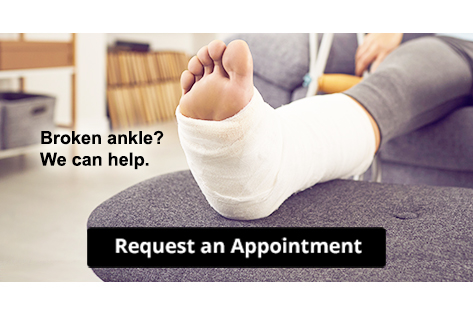Items filtered by date: October 2024
Common Causes of Ingrown Toenails
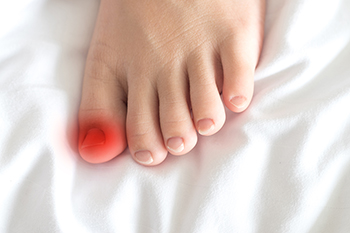
Ingrown toenails occur when the edge of the toenail grows into the surrounding skin, typically causing pain, redness, and swelling. They are most commonly found on the big toe, but any toenail can be affected. One of the primary causes of an ingrown toenail is wearing shoes that are too tight or ill-fitting, which can increase pressure on the toes. Engaging in activities like walking or sports in such footwear can make this issue worse. Additionally, improper toenail trimming, such as cutting the nails too short or rounding the edges, can encourage the nail to grow into the skin. People with naturally curved or thickened nails may be more prone to this condition. A chiropodist can help by carefully trimming the affected nail, reducing discomfort, and providing guidance on proper nail care to prevent recurrence. If you have a painful ingrown toenail, it is suggested that you make an appointment with a chiropodist for help.
Ingrown toenails may require medical attention. If you have significant pain or notice signs of infection from an ingrown toenail, please consult with Cynthia Chan, B.Sc., D.Ch from Healthy Advantage Foot & Orthotic Clinic. Our practitioner will assess your condition and provide you with quality foot and ankle treatment.
What Is an Ingrown Toenail?
An ingrown toenail occurs when the edges of a toenail grow into the surrounding skin. The toenails of the big toe are usually affected, however, an ingrown toenail can happen on any toe. Sometimes, the area can become infected leading to potentially serious complications. The ingrown toenail may be caused by improper trimming of the toenail, wearing ill-fitting shoes, or injury to the nail.
Symptoms
The symptoms of an ingrown toenail include:
Pain
Swelling
Redness
Warmth
Pus or drainage from the affected nail or a fever may indicate an infection of the area.
Treatment
Treatment depends on the severity of the ingrown toenail. In less severe cases, home treatment may be adequate. Soaking the affected foot in warm water and gently lifting the nail from the skin with a piece of clean cotton can help. In more severe cases, you may need to use topical or oral antibiotics to treat an infection. Surgical removal of the ingrown toenail may be required if more conservative treatments fail.
Ingrown toenails may be prevented by wearing well-fitted shoes and properly trimming the toenails. Toenails should be trimmed straight across and not too short when using nail clippers.
If you have any questions, please feel free to contact our office located in . We offer the newest diagnostic and treatment technologies for all your foot care needs.
Finding Shoes for Bunion Relief
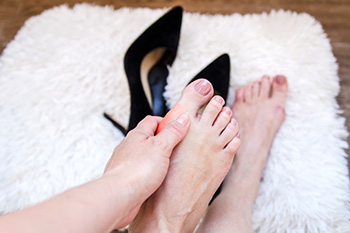
Choosing the right footwear is an important way to manage bunion pain and helps to prevent further complications. Bunions develop when the big toe shifts out of alignment, often made worse by wearing narrow or pointed shoes. This causes a bony bump that can make walking painful, especially if the shoe lacks space around the toe area. When selecting shoes for bunion relief, opt for styles with a wide toe box, lower heels, and soft, flexible materials that minimize pressure. Deep-toed shoes can provide additional space for orthotics or custom inserts, which help support the foot. A chiropodist can assess the severity of the bunion and recommend shoe modifications, such as adding orthotic devices or using shoe stretchers to widen the toe area. Properly fitting shoes reduce discomfort and allow room for any foot changes caused by the bunion. If you have a painful bunion, it is suggested that you schedule an appointment with a chiropodist for advice.
Bunions progressively worsen over time and may cause walking in your shoes to become difficult. To learn more about bunions, please consult with Cynthia Chan, B.Sc., D.Ch from Healthy Advantage Foot & Orthotic Clinic. Our practitioner will assess your condition and provide you with quality foot and ankle treatment.
What Are Bunions?
A bunion is a bony bump that protrudes from the base of the big toe. Bunions are caused due to a misalignment of the first metatarsal. The characteristic bump of a bunion forms when the metatarsal shifts outwards from its proper position. Bunions develop slowly over time and progressively worsen without treatment. The skin over the bunion may develop calluses due to the friction from shoes. Eventually, a bunion can make walking uncomfortable or even painful. Bunions are one of the most common foot deformities and are especially common in women and older adults.
Symptoms
A bunion appears as a bulging bump on the outside of the base of the big toe.
The bunion may also:
Be swollen, red, or sore
Develop corns or calluses over it
Cause pain
Limit the big toe’s range of motion
Treatment
There are several different treatments available for bunions. Conservative treatment options include wearing shoes with a wider toe box, cushioning the bunion with a specialized pad, wearing shoe inserts, icing the bunion if it becomes inflamed, and taking medications to relieve pain. In more severe cases, more invasive procedures may be done. This may involve removing the swollen tissue around the bunion, straightening the big toe, realigning the bones at the front of the foot, or a combination of these procedures.
If you have any questions, please feel free to contact our office located in . We offer the newest diagnostic and treatment technologies for all your foot care needs
Risk Factors of Athlete’s Foot

Athlete's foot, or tinea pedis, is a common fungal infection that affects the skin of the feet, primarily between the toes. The fungi typically thrive in warm, moist environments, making public showers, locker rooms, and shared towels common sources of transmission. Risk factors for athlete's foot include wearing tight or occlusive footwear, excessive sweating, and poor circulation. Symptoms of athlete's foot include itchy, scaly patches between the toes to blisters and thickened skin on the soles of the feet. While topical antifungal treatments are usually effective, stubborn cases may require oral antifungal medication. A chiropodist can accurately diagnose the infection, provide personalized treatment options, and suggest strategies to prevent recurrence. If you have a troublesome athlete's foot infection, it is suggested that you schedule an appointment with a chiropodist for guidance.
Athlete’s foot can be uncomfortable and unsightly. To learn more about preventing and treating this condition, please consult with Cynthia Chan, B.Sc., D.Ch from Healthy Advantage Foot & Orthotic Clinic. Our practitioner will assess your condition and provide you with quality foot and ankle treatment.
What Is Athlete’s Foot?
Athlete’s foot refers to an infection of the skin on the feet that is caused by a fungus. This fungus is contagious and thrives in warm and moist environments. It is often spread in common areas such as public pools, locker rooms, and showers. It can also spread when sharing personal items, like shoes or towels, with an infected person.
Symptoms
The symptoms of athlete’s foot may include:
Itching, stinging, or burning of the skin on the feet
Cracking or peeling skin, especially between the toes and on the soles of the feet
Scaly, red rash on the foot
Blisters
Foul odor
Treatment
Treatment for athlete’s foot typically involves using over-the-counter topical antifungal medications on the feet. When over-the-counter options are ineffective, you may need to take prescription oral medications or topical antifungal drugs, or a combination of both.
Prevention
Preventing athlete’s foot places an emphasis on good foot hygiene practices.
You can prevent athlete’s foot by:
Washing and drying your feet thoroughly every day
Wearing shoes when walking in public areas
Not sharing personal items, like shoes or socks, with others
Wearing shoes and socks made out of breathable materials
If you have any questions, please feel free to contact our office located in . We offer the newest diagnostic and treatment technologies for all your foot care needs.
Symptoms and Treatment of Morton’s Neuroma
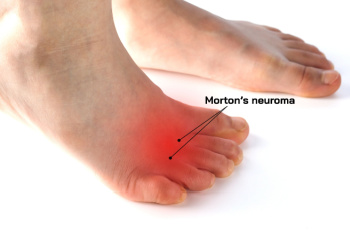
Morton's neuroma is a painful condition involving a thickened or irritated nerve in the ball of the foot, often between the third and fourth toes. It typically results from prolonged pressure or squeezing of the toes, often from wearing tight or high-heeled shoes. Symptoms of Morton’s neuroma include a burning sensation, sharp pain, or the feeling of a lump in the affected area, which worsens with walking or standing. A chiropodist can diagnose this condition through a physical examination and may recommend imaging tests like X-rays or ultrasounds. Treatment focuses on reducing pressure on the nerve, which includes wearing wider shoes and using custom shoe orthotics. If you have foot pain in the ball of the foot, it is suggested that you schedule an appointment with a chiropodist for a diagnosis and treatment.
Morton's neuroma can be highly uncomfortable. If you are experiencing the symptoms of Morton's neuroma, please consult with Cynthia Chan, B.Sc., D.Ch from Healthy Advantage Foot & Orthotic Clinic. Our practitioner will assess your condition and provide you with quality foot and ankle treatment.
What Is a Morton’s Neuroma?
Morton’s neuroma is a condition in which a nerve located in the ball of the foot between the third and fourth toes thickens due to compression or irritation. Common causes of Morton’s neuroma include wearing shoes with high heels or narrow toe boxes, participating in running or court sports, an injury or trauma to the area, or pressure being placed on the nerve from foot deformities such as bunions or hammertoes. Left untreated, Morton's neuroma may result in permanent nerve damage.
Symptoms
Symptoms of Morton’s neuroma often start gradually and worsen over time. Typical symptoms include:
Foot pain
Tingling, burning, or numbness in the affected foot
The unique sensation that something is inside the ball of the foot or that there is something stuck in your shoe while walking
Treatment
Non-surgical treatments for this condition may include padding or icing the affected foot, wearing an orthotic device, modifying activities or shoes to reduce pressure on the foot, and taking medications or getting injections to reduce pain and inflammation. Surgery may be needed if non-surgical treatments are ineffective.
If you have any questions, please feel free to contact our office located in . We offer the newest diagnostic and treatment technologies for all your foot care needs.
Ankle Fracture? Don’t Wait for Treatment
Factors in Choosing Running Shoes
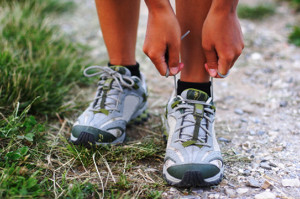
When choosing running shoes consider factors that affect comfort, performance, and injury prevention. First, consider the terrain you will be running on, whether road, trail, or mixed surfaces since different shoes are designed for varying conditions. Next, think about your preference for cushioning. Some runners prefer maximum cushioning for a soft, cloud-like feel while others want minimal cushioning for a more responsive connection to the ground. Gait support is also essential. While most runners need neutral shoes, those whose feet roll inward or outward may benefit from supportive designs. Proper sizing is key, so get your feet measured and try on shoes at the end of the day when the feet are the largest. Ensure the shoes offer a snug but not tight fit, leaving room for toe movement. Insoles or orthotics can also affect fit and support. If you have sustained a running injury or need advice on running shoes, it is suggested that you schedule an appointment with a chiropodist for guidance.
The right running shoes can sometimes be difficult to find. With so many options on the market, it’s important to know the unique needs of your feet prior to buying running shoes. If you require assistance, please consult with Cynthia Chan, B.Sc., D.Ch from Healthy Advantage Foot & Orthotic Clinic. Our practitioner can help you maintain the health of your lower limbs and your mobility.
When looking for running shoes, take into consideration:
The type of running you will be doing
The terrain you plan to run on
Your gait or running pattern
Your arch type
Other unique foot needs
A chiropodist can help by examining your feet and your gait to determine what types of shoes may be best for you. Some runners may require motion control shoes, which prevent your foot from rolling too far inward while you run. Others may need stability shoes, which offer more balance, cushioning, and support. When shopping for shoes, make sure that they are the right size, fit comfortably, and are made of breathable materials.
If you have any questions, please feel free to contact our office located in . We offer the newest diagnostic and treatment technologies for all your foot care needs.
